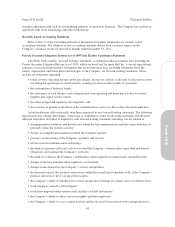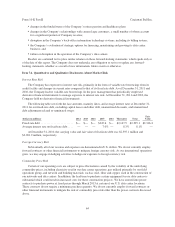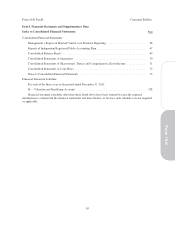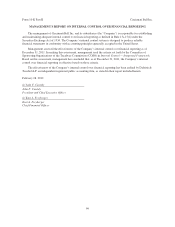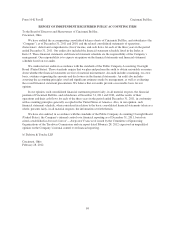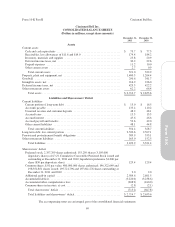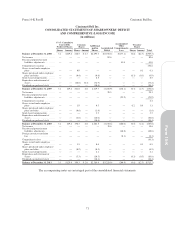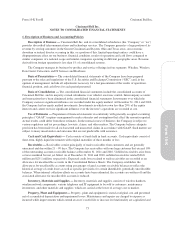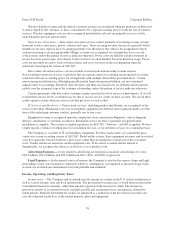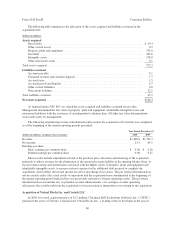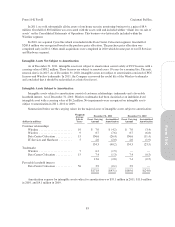Cincinnati Bell 2011 Annual Report Download - page 191
Download and view the complete annual report
Please find page 191 of the 2011 Cincinnati Bell annual report below. You can navigate through the pages in the report by either clicking on the pages listed below, or by using the keyword search tool below to find specific information within the annual report.
Form 10-K Part II Cincinnati Bell Inc.
Cincinnati Bell Inc.
NOTES TO CONSOLIDATED FINANCIAL STATEMENTS
1. Description of Business and Accounting Policies
Description of Business — Cincinnati Bell Inc. and its consolidated subsidiaries (the “Company” or “we”)
provides diversified telecommunications and technology services. The Company generates a large portion of its
revenue by serving customers in the Greater Cincinnati and Dayton, Ohio and Texas areas. An economic
downturn or natural disaster occurring in this, or a portion of this, limited operating territory could have a
disproportionate effect on our business, financial condition, results of operations and cash flows compared to
similar companies of a national scope and similar companies operating in different geographic areas. Revenue
derived from foreign operations is less than 1% of consolidated revenue.
The Company manages its business by product and service offerings in four segments: Wireline, Wireless,
Data Center Colocation, and IT Services and Hardware.
Basis of Presentation — The consolidated financial statements of the Company have been prepared
pursuant to the rules and regulations of the U.S. Securities and Exchange Commission (“SEC”) and, in the
opinion of management, include all adjustments necessary for a fair presentation of the results of operations,
financial position, and cash flows for each period presented.
Basis of Consolidation — The consolidated financial statements include the consolidated accounts of
Cincinnati Bell Inc. and its majority-owned subsidiaries over which it exercises control. Intercompany accounts
and transactions have been eliminated in the consolidated financial statements. Investments over which the
Company exercises significant influence are recorded under the equity method. At December 31, 2011 and 2010,
the Company had no equity method investments. Investments in which we own less than 20% of the equity
interests and cannot exercise significant influence over the investee’s operations are recorded at cost.
Use of Estimates — Preparation of financial statements in conformity with generally accepted accounting
principles (“GAAP”) requires management to make estimates and assumptions that affect the amounts reported.
Actual results could differ from those estimates. In the normal course of business, the Company is subject to
various regulatory and tax proceedings, lawsuits, claims, and other matters. The Company believes adequate
provision has been made for all such asserted and unasserted claims in accordance with GAAP. Such matters are
subject to many uncertainties and outcomes that are not predictable with assurance.
Cash and Cash Equivalents — Cash consists of funds held in bank accounts. Cash equivalents consist of
short-term, highly liquid investments with original maturities of three months or less.
Receivables — Receivables consist principally of trade receivables from customers and are generally
unsecured and due within 21 – 90 days. The Company has receivables with one large customer that exceed 10%
of the outstanding accounts receivable balance at December 31, 2011 and 2010. Unbilled receivables arise from
services rendered but not yet billed. As of December 31, 2011 and 2010, unbilled receivables totaled $26.8
million and $25.1 million, respectively. Expected credit losses related to trade receivables are recorded as an
allowance for uncollectible accounts in the Consolidated Balance Sheets. The Company establishes the
allowances for uncollectible accounts using percentages of aged accounts receivable balances to reflect the
historical average of credit losses as well as specific provisions for certain identifiable, potentially uncollectible
balances. When internal collection efforts on accounts have been exhausted, the accounts are written off and the
associated allowance for uncollectible accounts is reduced.
Inventory, Materials and Supplies — Inventory, materials and supplies consists of wireless handsets,
wireline network components, various telephony and IT equipment to be sold to customers, maintenance
inventories, and other materials and supplies, which are carried at the lower of average cost or market.
Property, Plant and Equipment — Property, plant and equipment is stated at original cost and presented
net of accumulated depreciation and impairment losses. Maintenance and repairs are charged to expense as
incurred while improvements which extend an asset’s useful life or increase its functionality are capitalized and
73
Form 10-K


